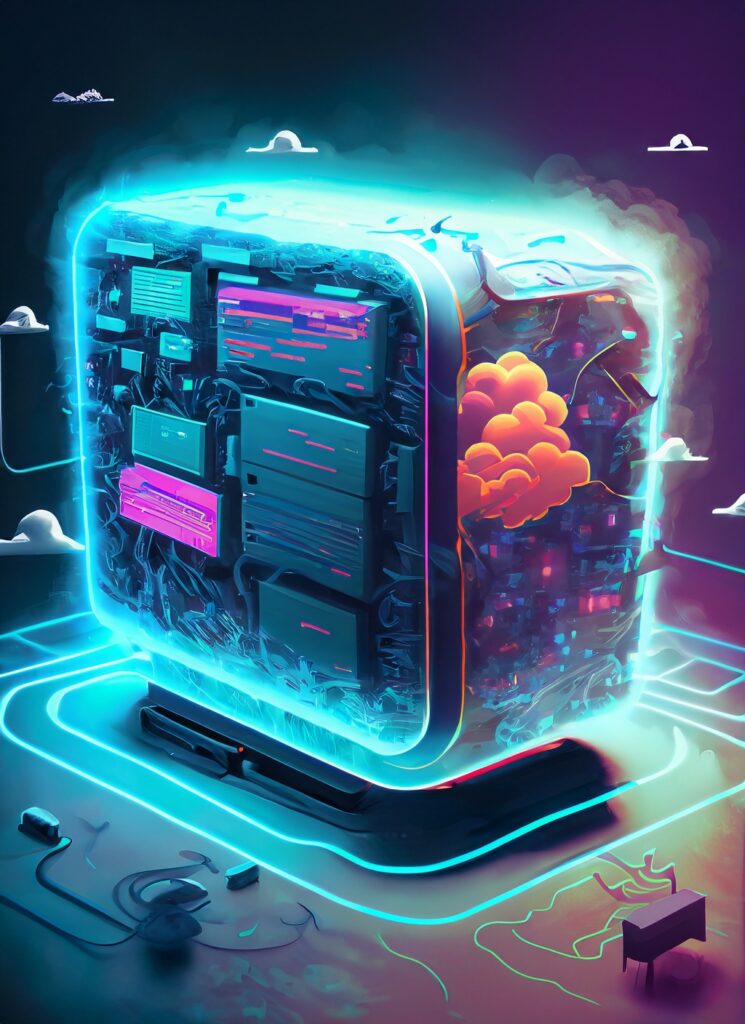
VMs
Virtual Machines
Virtualize with VMs
Virtual Machines (VMs) are software-based replicas of physical computers, enabling multiple operating environments on a single hardware system.
In the vast realm of computing, there’s a concept that has been pivotal in revolutionizing the way we utilize hardware resources, test software, and even deploy scalable applications. Enter the world of Virtual Machines (VMs). But what exactly are they? Let’s dive in.
What are Virtual Machines (VMs)?
A Virtual Machine (VM) is essentially a software-based simulation of a physical computer. It runs in an isolated environment on a host machine, allowing you to operate multiple operating systems on a single physical machine. Think of it as a computer within a computer, where the inner computer (the VM) believes it’s a real, physical machine, but in reality, it’s just a simulation managed by the outer, actual computer.
Here’s a fun analogy:
Imagine you’re in a massive hotel (the host machine) with numerous rooms (the VMs). Each room is self-contained, with its own environment, furniture, and amenities. The guests in each room believe they’re in their own separate building, but in reality, they’re all under the same roof, sharing the hotel’s resources.
What are Virtual Machines (VMs)?
A Virtual Machine (VM) is essentially a software-based simulation of a physical computer. It runs in an isolated environment on a host machine, allowing you to operate multiple operating systems on a single physical machine. Think of it as a computer within a computer, where the inner computer (the VM) believes it’s a real, physical machine, but in reality, it’s just a simulation managed by the outer, actual computer.
Curious about the top 5 features of a VM?
I'll do you one better and provide 6. Here are the top 6 reasons to consider using a VM!
VMs provide an isolated environment, ensuring that the actions or failures in one VM don’t affect others. This is especially useful for testing new software or updates without risking the main system.
VMs allow for efficient use of hardware resources. Instead of having multiple physical machines for different tasks, you can have several VMs on one machine, each allocated a portion of the host’s resources.
Need to run a Linux application on your Windows machine? No problem! With VMs, you can run multiple operating systems on a single host.
VMs can be snapshotted to capture their current state, allowing you to revert back if needed. They can also be cloned to create identical environments for testing or deployment.
VMs can be moved between host machines with minimal downtime, ensuring high availability and load balancing.
By consolidating multiple VMs on a single physical server, businesses can reduce the need for hardware, leading to significant savings on equipment, energy, and maintenance costs.
VMs provide an isolated environment, ensuring that the actions or failures in one VM don’t affect others. This is especially useful for testing new software or updates without risking the main system.
VMs allow for efficient use of hardware resources. Instead of having multiple physical machines for different tasks, you can have several VMs on one machine, each allocated a portion of the host’s resources.
Need to run a Linux application on your Windows machine? No problem! With VMs, you can run multiple operating systems on a single host.
VMs can be snapshotted to capture their current state, allowing you to revert back if needed. They can also be cloned to create identical environments for testing or deployment.
VMs can be moved between host machines with minimal downtime, ensuring high availability and load balancing.
By consolidating multiple VMs on a single physical server, businesses can reduce the need for hardware, leading to significant savings on equipment, energy, and maintenance costs.
Types of Virtual Machines
lets quickly get done with the boring parts ....
Virtual Machines (VMs) have become a staple in the world of computing. They allow us to run multiple operating systems on a single physical machine, providing flexibility, isolation, and resource optimization. But did you know there are different types of VMs?
In full virtualization, a hypervisor is used to emulate the underlying hardware. This allows multiple OS instances to run simultaneously, with each believing it has access to the actual hardware. The hypervisor manages these guest OSs and ensures they don’t interfere with each other.

Unlike full virtualization, paravirtualization doesn’t completely emulate the hardware. Instead, the guest OS is modified to be aware of the hypervisor. This means the guest OS can make direct calls to the hypervisor, leading to better performance.
This type doesn’t use a hypervisor at all. Instead, it relies on the host OS to create isolated spaces known as containers. Each container shares the host OS’s kernel but runs its own instance of user space applications and libraries.

Wait up...
What's a Hypervisor?
Okay, last techy bit, I promise!
Imagine a hypervisor as a super cool video game console. But instead of just playing one game at a time, it lets you play multiple games all at once. This “console” (hypervisor) can run different “games” (operating systems) on one TV (computer) without them messing with each other.
It’s like having a magic box that lets you play Xbox, PlayStation, and Nintendo games all on one screen. And the best part? They don’t know they’re sharing the same TV!
Type 1 Hypervisor (Bare-metal)
This is like a pro-level gaming console. It doesn’t need any other device to work; it just runs the games directly. It’s super fast, safe, and perfect for hardcore gamers.
Good Stuff:
- Speed: It’s lightning fast because there’s nothing slowing it down.
- Safety: Less stuff means fewer chances for things to go wrong.
- Big Player: Perfect if you’re running a big gaming event.
Not-so-good Stuff:
- Tricky: It’s like setting up a big gaming rig; needs some skills.
- Pricey: Might cost more, especially if you want the best gear.
Type 2 Hypervisor (Hosted)
This one’s like a gaming app on your phone or computer. It uses the device’s system to run the games. It’s great for casual gamers or if you just want to try out different games.
Good Stuff:
- Chill: Easy to use and doesn’t need any fancy gear.
- Handy: Perfect for playing around or testing new games.
- Wallet-friendly: Can be cheaper, especially if you’re using free games.
Not-so-good Stuff:
- Speed: Might be a bit slower since it’s like playing through another device.
- Safety: More parts mean more chances for glitches.
PS. In above analogy -> Games = Operating Systems
Key Considerations When Using Virtual Machines
Virtual Machines (VMs) have become an integral part of the modern IT landscape. They offer a myriad of benefits, from improved resource utilization to enhanced security. However, like all technologies, VMs come with their own set of considerations.
While VMs offer many advantages, it’s essential to approach them with a clear understanding of their potential challenges. By keeping these considerations in mind, you can harness the power of VMs while mitigating potential pitfalls.
You have been warned

VMs (Virtual Machines) are like separate computers running inside your main computer. But if you have too many, they can slow things down because each one acts like it's using its own computer system.
If you don't set up your VMs right, they can make your computer slow. It's like trying to run too many apps at once.
VMs can be safe, but they're not invincible. Think of them as rooms in a house; if someone breaks into one room, the other rooms might be at risk too. So, always keep them locked and safe!
Just like you save your game progress, you need to save your VMs. But saving a snapshot of your VM isn't enough; you need a full backup plan.
Some software in VMs might cost extra money because of how they're licensed. It's like paying for extra features in a game.
It's easy to make lots of VMs, but if you're not careful, you'll have too many to manage. Imagine having too many pets and not knowing which one to feed!
Fitting VMs into your computer system can be tricky. It's like trying to fit a new piece into a puzzle that's already complete.
VMs need special care. It's like learning to play a new game; you need to know the rules and strategies to win.
The End
With this knowledge on Virtual Machines (VMs), you're well-equipped to embark on your journey in your preferred cloud environment. Dive in and explore the limitless possibilities!
